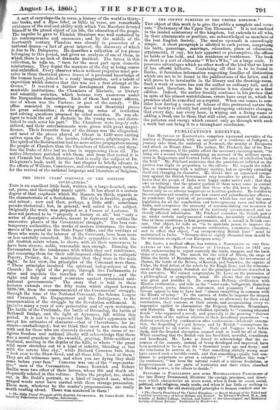THE FIFTY YEARS' STRUGGLE OF THE SCOTTISH COVENANTERS. * Tins is
an excellent little book, written in a large-hearted, earn- est, pious, and thoroughly manly spirit. It has about it a certain degree of that emphasis which Mr. Masson, we think, regards as
the characteristic of a Scotohman. The style is forcible, graphic, and robust ; now and then, perhaps, a little stiff; sometimes pseudo-rhetorical ; but, in general, well suited to the subject. Originally the work was prepared as a Course of Lectures. It does not pretend to he "properly a history at all," but "only a
series of descriptive sketches, meant to represent in outline the
successive phases of the Covenanters' struggle." The best con- temporary authorities, the works of modern historians, the docu- mentsof the period in the State Paper Office, and the writings of those who wrote in the interest of the Covenant, have been more or less carefully consulted. Mr. Dodd's sympathies lie with the , old Scottish saints whom, he shows, with all their narrowness, to have been sincere, noble, reasonable men enough. Blaming the Covenanters for the intolerance with which they met intolerance, , and censuring them for their self-imposed obligation to extirpate ' Popery, Prelacy, &c., he maintains that they were in the main right. In his view, the principles of the Covenant were three. " Those principles, involved the spiritual independence of the Church ; the right of the people, through free Parliaments, to raise and regulate the taxation of the country ; and the
right and duty of armed resistance against tyrannical anti- national governments." The story that is told in these lectures extends over the fifty years. which. elapsed between 1638-'88., from the commencement' of the Covenanters' struggle, ' through the time of the National Covenant, the Solemn League and Covenant, the Engagement and the Indulgence, to the consummation of the struggle by the Revolution settlement. It incite:lee many a year of sore persecution and of open resistance. The battle of the Pentlands, the battle of Drumelog, the battle of Bothwell Bridge, and the fight at Ayrsmoss, fall within this period. It is not to be expected that Mr. Dodd's opponents will accept his estimates of character—that of Claverhouse, -for in- stance—unchallenged ; but we think that most men who can feel with and for those who are sincerely devoted to the cause of re- ligious freedom and national liberty will acknowledge that there was a moral grandeur in- the sworded, praying, Bible-soldiers of Scotland, meeting in the depths of the hills, or where "the great wild moor stretches out to a kind of infinity, blending at last with the serene blue sky," while Richard Cameron bids them "look over to the Shaw-head, and all those hills. Look at them ! They are all witnesses BOW, and when you are dying they shall come before your face." Cameron was one of the "representa- tive" men of the Covenanters. James Renwick and Robert Baillie were two other ef their heroes whose life and death are eloquently relate& in this. volume. Peden the prophet; too, stands net, in Mr. Dodd's portrait, as a kind of inspired man, whose winged words must have carried with them. strange-persuasion. These men, whatever be the reader's prepossessions, are really worth, reading about. There was manhood in them !
I,The _Wig rears'. Struggle of the &Mile& Covenanter,. By James Dodd. Pub- lished by Edmonston and Douglas, Edinburgh.


























 Previous page
Previous page